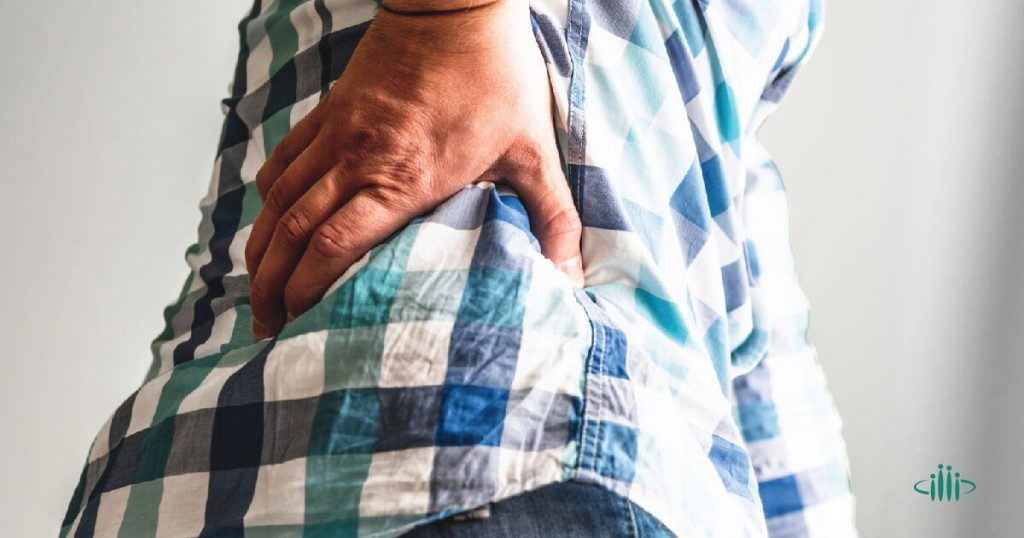
We’ve Got Your Back
With 24 vertebrae and 23 disks, plus nerves, the spinal column and muscles—all working together—it’s no wonder that back pain is so common.
“In fact, back pain is probably the most common condition after the common cold that brings patients in to see their family doctor,” says Robert E. Johnson, DO, fellowship-trained orthopedic spine surgeon at the Idaho Back Institute, a proud member of Bingham Healthcare. It’s estimated that half of all working Americans experience back pain symptoms every year. Those symptoms can be minor twinges or extreme pain that keeps you from simple tasks.
Ready for the good news? Most aches and pains are easily treated and often don’t require much more than a little TLC. But that doesn’t mean you get to sit on the couch and watch TV. As a matter of fact, the less you move, the more pain you’re likely to have.
“Staying active will help the pain fade faster—and keep it from coming back,” says Dr. Johnson. “In most cases, add in nonsurgical treatments like over-the-counter or prescription medications, physical therapy, and posture training, and you likely will be back to normal in no time.”
Here’s a look at what could be behind that pain in your back.
OVERACTIVITY
Symptoms: Lower-back pain that can range from achy to stabbing, accompanied by stiffness and limited range of motion.
What’s happening: You’re probably familiar with this type of backache—the most common source of back pain. “Tightness or fatigue in the muscles can result from overworking, poor posture, or unusual activities for that person,” Dr. Johnson says. “The muscles are reacting to the changes and protesting by causing pain in the lower back.”
Have you started a new exercise routine? Or maybe you spent the day in your garden or shoveling snow for the first time in winter. Overactivity is likely the culprit.
What’s next: While you can expect the pain to settle down in a few days, it’s important to maintain some level of activity in the meantime. Mild exercise will speed up your recovery. If the pain doesn’t go away in 48 hours, make an appointment with your doctor, Dr. Johnson suggests. Once you feel better, work to strengthen your back and abdominal muscles to avoid future strains
HERNIATED DISK
Symptoms: Sharp leg or hip pain, or both, usually relegated to one side of the body; may include back pain and numbness.
What’s happening: Think of the intervertebral disks in your spine as jelly-filled shock absorbers that sit between each of your vertebrae. A herniated disk occurs when the intervertebral disk’s gooey center pushes against the hard outer ring that houses it, putting pressure on nearby nerves, which can lead to numbness. When the nerves that serve a particular body part are affected, you likely will lose feeling in that area or experience a tingling sensation.
So what makes the disk bulge in the first place? Certain movements, including lifting, bending, twisting or pulling. It is most common in the lower back and is also known as a slipped disk.
What’s next: Avoid strenuous activity and talk to your doctor about what medication might help. “While most people respond well to this treatment and can return to normal activities, some may need steroid injections or surgery,” Dr. Johnson says.
ARTHRITIS
Symptoms: Stiffness and pain in the neck or lower back, especially when getting up in the morning or after sitting for long periods.
What’s happening: Many forms of arthritis cause back pain. The most likely culprit is osteoarthritis, which causes joints to wear out faster. That’s because the disease erodes your cartilage, allowing bones to rub against each other and leaving pain, stiffness, and bony overgrowths (or spurs) behind.
Rheumatoid arthritis is another form of arthritis. In people who have this autoimmune disease, the body’s immune system attacks the tissue that lines the joints. Joint pain and inflammation are common.
What’s next: If your doctor thinks arthritis may be to blame for your aches and pains, he or she may order an X-ray, an MRI and blood tests. For those with osteoarthritis, your physician may recommend treatment that includes exercise, weight management and medication. If those don’t work, surgery is an option in severe cases.
SPINAL STENOSIS
Symptoms: Pain, especially when walking or standing; numbness in the back, legs, arms, or neck, or all those areas.
What’s happening: This typically happens as we get older, specifically to those 50 and older. The spinal column—the tube through which your nerves travel—narrows. This puts pressure on your spinal nerves and spinal cord. Arthritis and scoliosis can lead to spinal stenosis, as can previous herniated disks.
“People with spinal stenosis typically have trouble walking or standing for long periods,” Dr. Johnson says. “Often, you’ll see that they’ll lean on grocery carts. They find when they lean forward, they feel more comfortable because space opens for the nerve sack.”
What’s next: It’s important to see your doctor if you think you have spinal stenosis, because the pain will only increase in time. Typical treatments include physical therapy, cold or heat packs, and medication.
SCIATICA
Symptoms: Sharp or burning pain in the legs or buttocks, usually on one side of the body; some may feel pain all the way down the back of their leg to their foot.
What’s happening: The sciatic nerve is the largest nerve in the body, starting in the lower back and running down the back of the legs to the feet. When something puts pressure on this nerve or it becomes damaged, you feel pain. It’s a warning sign because sciatic pain can signal another condition such as a herniated disk or a pelvic injury.
What’s next: “I always try to pinpoint the underlying cause and come up with treatment based on that finding,” Dr. Johnson says. “In general, though, your options include applying hot and cold packs, stretching, and taking over-the-counter medications. A lot of the time, the pain will disappear on its own.”
WORLD-CLASS SPINE CARE IN EASTERN IDAHO
Dr. Robert Johnson is one of the most experienced and distinguished orthopedic spine surgeons in the region. He treats people with a wide variety of spinal conditions of the neck and back, and he specializes in several areas of spine surgery.
His primary goal as a physician, though, is to help patients obtain some relief from their ailments so they can keep doing what they love. He strongly believes in exhausting all conservative means to treat a wide variety of spinal conditions of the neck and back before suggesting surgery.
He welcomes patients in Idaho Falls, Blackfoot, and Pocatello. Appointments can be scheduled by calling (208) 235-2277. Se habla Español
Have You Heard about the Mazor X?
Bingham Memorial is among the world’s first hospitals to use a new tool in robot-guided spinal surgery—the Mazor X system. Dr. Johnson uses the Mazor X robotic equipment during spine surgery, and is one of the only physicians in the U.S. who has been trained to do so. Performing a robot-assisted spine surgery allows him to have greater precision and make smaller incisions, which translates into shorter hospital stays, better clinical outcomes, and faster return to everyday activities.
About the Mazor X Robotic System
Please visit: https://binghamhealthcare.org/physician-specialties/mazor-x/www.BinghamMemorial.org/Mazor-
Our content is reviewed regularly and is updated when new and relevant evidence is made available. This information is neither intended nor implied to be a substitute for professional medical advice. Always seek the advice of your physician or other qualified health provider prior to starting any new treatment or with questions regarding a medical condition.



